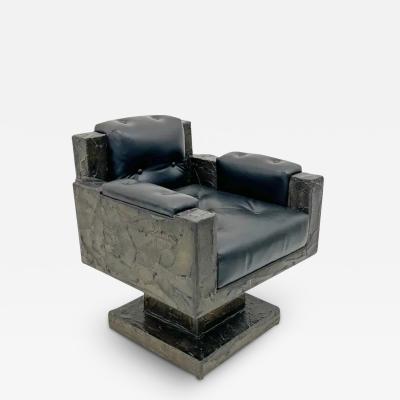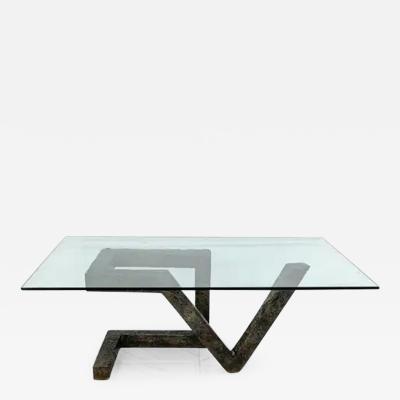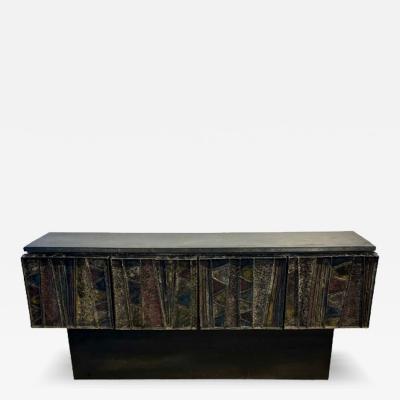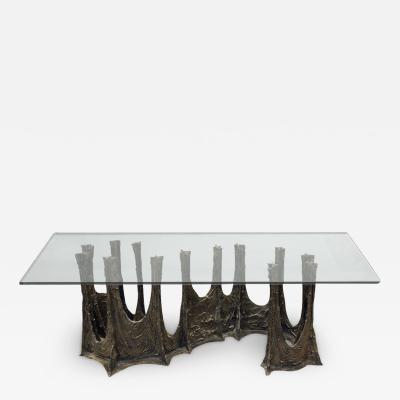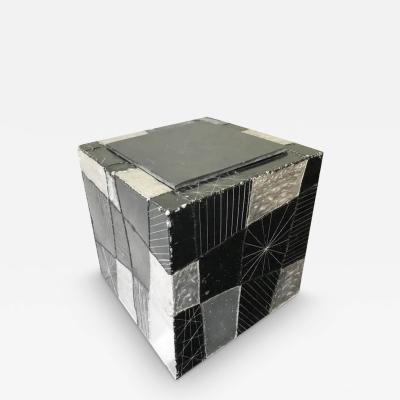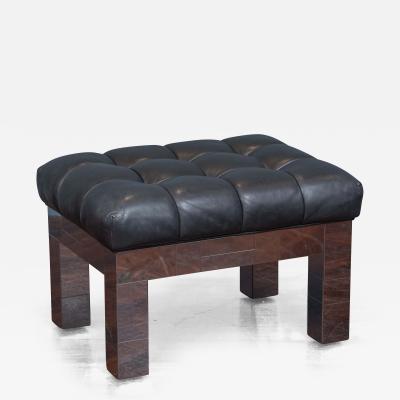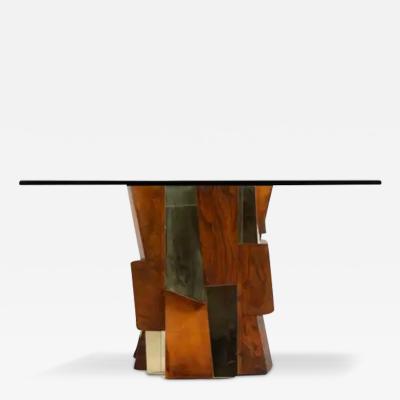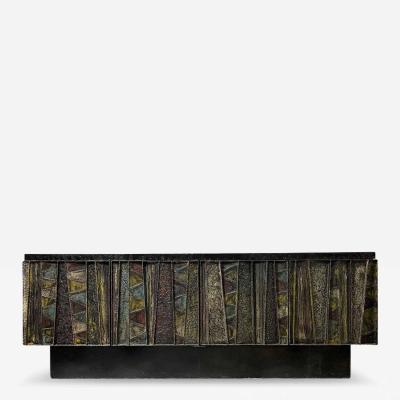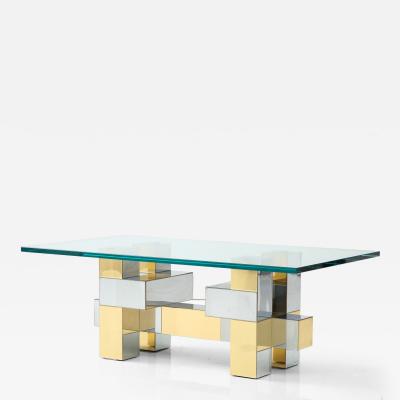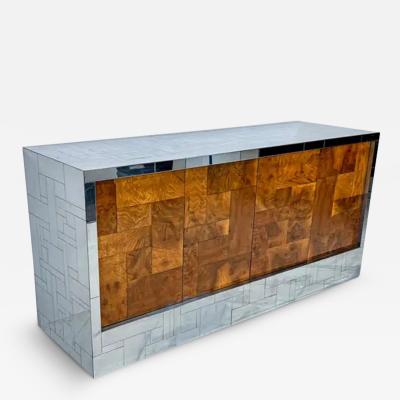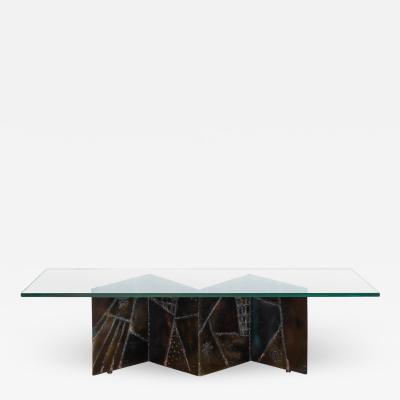Paul Evans
American, 1931 - 1987
Paul Evans (1931-1987) was a leading figure in the mid century American studio and brutalist furniture movement. Evans consistently pushed boundaries with his innovative approaches to metalsmithing and furniture-making. His transcendent works, which defied what everyday objects looked like and how they were made, continue to reveal the fascinating crosscurrents between sculpture and design. Evans began working with metal in the early 1950s— first at the Rochester Institute of Technology’s School for American Craftsmen (SAC) in Rochester, New York, where he studied under the influential American silversmiths and designers John (Jack) Prip and Lawrence Copeland, and later at the Cranbrook Academy of Art in Bloomfield Hills, Michigan. Evans then moved to Sturbridge Village, Massachusetts, where he worked as a full-time craftsman, demonstrating various silversmithing techniques at Old Sturbridge Village, a living museum that re-creates life in rural New England during the eighteenth and nineteenth-centuries. In 1955, seeking a change of scenery, Evans moved to Lambertville, New Jersey, a well-known haven for artists and craftsmen, and opened a workshop in a former chicken coop.
He soon befriended the self-taught furniture designer, Phillip Lloyd Powell, who encouraged Evans to take his metallurgy skills and apply them to furniture. For the next ten years, the duo shared a showroom in nearby New Hope, Pennsylvania, and collaborated on pieces that melded Powell’s wood prowess and Evans’ metalworking skills. The late 1950s and 1960s were an incredibly important period for Evans as his workshop operation continued to grow and he began producing some of his most celebrated forms. In 1964, Evans became a featured designer for the furniture manufacturer Directional Furniture, an association that significantly impacted the nature and scope of his production.
Evans introduced several lines, including the Sculpted Bronze series (mid-1960s), which involved applying epoxy resin over a plywood base or steel frame, shaping it by hand, and coating it with atomized bronze; the Argente series (late 1960s to early 1970s), which featured aluminum and pigment-infused metal surfaces welded together (a process that was deemed highly toxic and quickly abandoned) to create abstract forms; and the popular Cityscape series (1970s), which was inspired by the Manhattan skyline. Boasting sleek, elegant surfaces made of brass and chrome, the Cityscape series differed greatly from Evans’ sculpted steel works of the 1960s, which were painted and highly-textured. The Cityscape series garnered significant recognition for Paul Evans furniture and established Directional Furniture as one of the most notable mid century design companies of the twentieth century. In 1966, Evans relocated to Plumsteadville, Pennsylvania, where he opened a larger workshop. Independent of his work for Directional, Evans continued to create prototypes, produce commissions, and craft his celebrated sculpture-front screens, sideboards, collages, chairs, and tables, which featured high-relief, hand-forged decorative elements. In 1979, Evans opened a second showroom in New York City. Evans died of a heart attack in 1987, shortly after retiring to Massachusetts.
Cover Shot: Paul Evans at work in Aquetong Road Shop, 1966. Photography by Jeff Baumann.
Incollect Articles: The Untamed Genius of Paul Evans
He soon befriended the self-taught furniture designer, Phillip Lloyd Powell, who encouraged Evans to take his metallurgy skills and apply them to furniture. For the next ten years, the duo shared a showroom in nearby New Hope, Pennsylvania, and collaborated on pieces that melded Powell’s wood prowess and Evans’ metalworking skills. The late 1950s and 1960s were an incredibly important period for Evans as his workshop operation continued to grow and he began producing some of his most celebrated forms. In 1964, Evans became a featured designer for the furniture manufacturer Directional Furniture, an association that significantly impacted the nature and scope of his production.
Evans introduced several lines, including the Sculpted Bronze series (mid-1960s), which involved applying epoxy resin over a plywood base or steel frame, shaping it by hand, and coating it with atomized bronze; the Argente series (late 1960s to early 1970s), which featured aluminum and pigment-infused metal surfaces welded together (a process that was deemed highly toxic and quickly abandoned) to create abstract forms; and the popular Cityscape series (1970s), which was inspired by the Manhattan skyline. Boasting sleek, elegant surfaces made of brass and chrome, the Cityscape series differed greatly from Evans’ sculpted steel works of the 1960s, which were painted and highly-textured. The Cityscape series garnered significant recognition for Paul Evans furniture and established Directional Furniture as one of the most notable mid century design companies of the twentieth century. In 1966, Evans relocated to Plumsteadville, Pennsylvania, where he opened a larger workshop. Independent of his work for Directional, Evans continued to create prototypes, produce commissions, and craft his celebrated sculpture-front screens, sideboards, collages, chairs, and tables, which featured high-relief, hand-forged decorative elements. In 1979, Evans opened a second showroom in New York City. Evans died of a heart attack in 1987, shortly after retiring to Massachusetts.
Cover Shot: Paul Evans at work in Aquetong Road Shop, 1966. Photography by Jeff Baumann.
Incollect Articles: The Untamed Genius of Paul Evans
Paul Evans
Early Paul Evans Sculpted Bronze Throne Chair, Signed and Dated, 1969
H 33 in W 28 in D 29 in
$ 48,000
Paul Evans
Brutalist Cast Metal Geometric Dining Table in the Manner of Paul Evans
H 29 in W 78 in D 48 in
$ 15,300
Paul Evans
Paul Evans Mid-Century Modern Brutalist Deep Relief Credenza / Sideboard, Signed
H 33 in W 72 in D 17 in
$ 70,000
Paul Evans
Set of Four Chrome Cityscape Chairs by Paul Evans for Directional
H 34 in W 21 in D 26 in
$ 6,000
Paul Evans
IMPORTANT POLYCHROMED WELDED STEEL "DEEP RELIEF"' CREDENZA BY PAUL EVANS
H 31 in W 84 in D 20 in
$ 110,000
Paul Evans
RARE EARLY PAUL EVANS DIMINUTIVE SLATE AND SCULPTED METAL TABLE
H 16 in DIA 18 in
$ 20,000
Paul Evans
Paul Evans Rare and Important "Argente" 2-Door Cabinet 1968 (Signed and Dated)
H 32 in W 48 in D 20 in
$ 95,000
Paul Evans
Exceptional Large Signed Paul Evans 1969 Directional Sclupted Bronze Wall Unit
H 96 in W 156 in D 18 in
$ 60,000
Paul Evans
Paul Evans Burl and Chrome Cityscape Credenza, Directional, Signed, 1970s
H 32 in W 67 in D 21 in
$ 16,000
Paul Evans
Paul Evans for Directional Mid Century Chrome Cantilever Dining Chairs
H 33 in W 19 in D 23 in
$ 6,995
Paul Evans
Paul Evans PE-11 Angle Zig Zag Cocktail Table for Directional
H 16 in W 60 in D 24 in
$ 7,500
Access Trade Price
Paul Evans
Exceptional Paul Evans for Directional Model PE24 Brutalist Welded Dining Table
H 29 in W 95 in D 50 in
